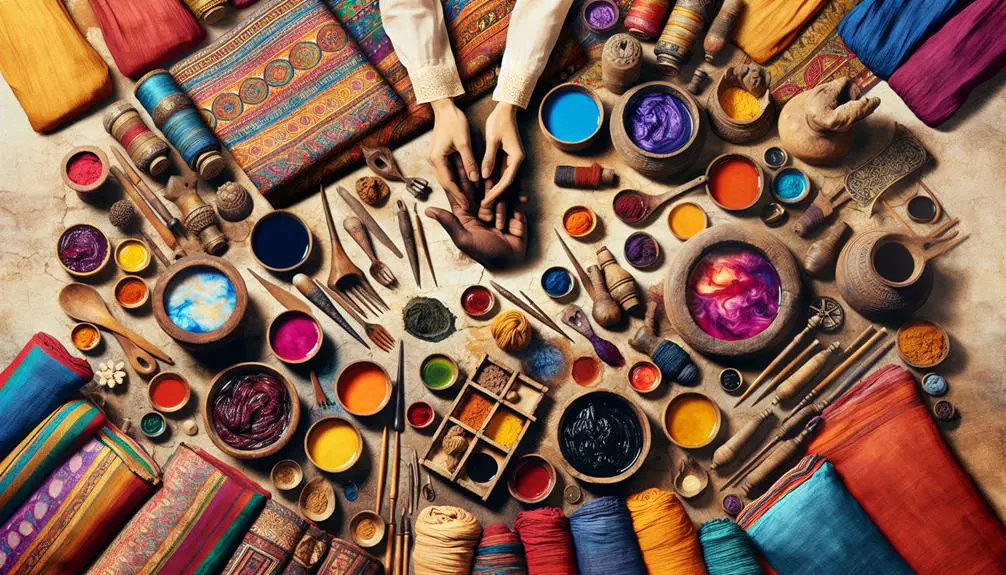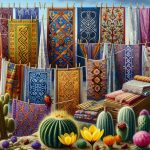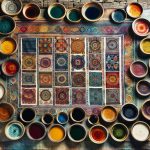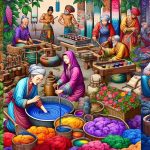When you think about fabric dyeing, you might not realize just how far back its history stretches. Imagine ancient Egyptians meticulously extracting colors from plants and minerals, or medieval Europeans experimenting with new methods to produce vibrant hues. From the rich blues of indigo to the deep reds of madder root, each era brought its own innovations and challenges. But what exactly were these techniques, and how did they evolve over centuries to become the sustainable practices we see today? Understanding this journey can offer fascinating insights into both artistry and technological advancement.
Table of Contents
Key Takeaways
- Ancient cultures used natural dyes from plants, minerals, and insects for vibrant colors.
- Egyptians mastered indigo and madder root dyes for rich blues and reds.
- Medieval Europeans relied on mordants for dye adherence using sources like woad and weld.
- Renaissance artisans innovated with mordanting and resist dyeing techniques like batik and ikat.
- The Industrial Revolution's mechanization enabled large-scale, consistent fabric dyeing with chemicals.
Ancient Natural Dyes
Ancient natural dyes, derived from plants, minerals, and insects, have been used for thousands of years to color fabrics.
As you explore the world of ancient textiles, you'll discover that these dyes were more than just sources of color—they were integral to traditional practices and cultural expressions.
Imagine the vibrant reds from madder root or the deep blues from indigo leaves, each extracted through thorough processes honed over generations.
You'd find that ancient artisans didn't merely dye fabric; they transformed it through a deep understanding of their natural environment.
Using mordants like alum or iron, they made sure the dyes bonded well with the fabric, achieving lasting hues that spoke volumes about their expertise.
Egyptian Dyeing Methods
You'll find that ancient Egyptian dyeing methods relied heavily on natural plant extracts for vibrant colors.
They used specific tools to guarantee the dyeing process was effective and consistent.
Each color held symbolic meanings, reflecting their cultural significance and beliefs.
Natural Plant Extracts
Egyptians mastered the art of dyeing fabrics with natural plant extracts, creating vibrant colors that have stood the test of time. By harnessing botanical pigments, they adhered to sustainable practices that modern eco-conscious artisans aim to replicate. Natural plant extracts, such as indigo and madder root, were the cornerstone of eco-friendly textile dyes, applied through traditional methods that guaranteed longevity and brilliance.
To gain a deeper understanding, let's explore the key elements involved:
| Plant Extract | Color Produced | Application Method |
|---|---|---|
| Indigo | Blue | Fermentation |
| Madder Root | Red | Boiling and soaking |
| Weld | Yellow | Steeping in hot water |
| Pomegranate Rind | Yellow/Brown | Simmering and soaking |
These ancient Egyptians didn't just dye fabrics; they crafted a legacy of color that's both beautiful and eco-friendly. Their sustainable practices are evident in the way they sourced and processed botanical pigments, minimizing their environmental footprint. By following these traditional methods, you can achieve similar results, blending historical authenticity with modern sustainability.
Mastering these techniques not only connects you with history but also promotes eco-friendly textile dyes, ensuring your creations are both vibrant and environmentally conscious.
Dyeing Process Tools
To replicate Egyptian dyeing methods, you'll need a few essential tools that have stood the test of time in creating vibrant, long-lasting colors. Mastering these ancient techniques requires both understanding and using the right traditional tools. Here's a handy list to get you started:
- Mortar and Pestle: Essential for grinding natural plant extracts into fine powders, perfect for dye preparation.
- Clay Pots: Used for heating and mixing dyes, these pots retain heat well and distribute it evenly, critical for consistent dye application.
- Wooden Stirrers: Ideal for stirring dye mixtures, wooden stirrers help maintain the integrity of the dye while making sure it's thoroughly combined.
- Linen Cloths: Used for straining and filtering dye solutions, ensuring a smooth, particle-free dye.
Maintaining your equipment is essential for consistent results. Regularly inspect your mortar and pestle for cracks, as damaged tools can impact the fineness of your dye powders.
Keep clay pots clean and free from residues to prevent contamination of colors. Wooden stirrers should be wiped down thoroughly after each use to avoid dye build-up.
Lastly, make sure your linen cloths are washed and dried properly after each dyeing session.
Symbolic Color Meanings
Immerse yourself in the rich tapestry of ancient Egypt, where colors were imbued with profound symbolic meanings that influenced every aspect of life.
As you explore Egyptian dyeing methods, you'll uncover that each hue carried deep cultural significance. For instance, the color green, derived from malachite, symbolized fertility and rebirth, often used in the garments of the living and the dead to guarantee prosperity in both worlds.
Red, extracted from ochre and madder, was associated with power, vitality, and chaos. It adorned the attire of warriors and pharaohs, symbolizing their strength and vigor.
Conversely, the color white, achieved through naturally bleached linen, represented purity and sacredness, often reserved for religious ceremonies and priestly garments.
Blue, created from lapis lazuli and indigo, held divine connections, symbolizing the heavens and the Nile. It was used in the regalia of gods and royalty, emphasizing their celestial and sovereign nature.
Finally, yellow, produced from saffron and other plants, signified the eternal and the divine, frequently seen in the funerary textiles of the elite to denote their journey to the afterlife.
Understanding these symbolic color meanings enriches your appreciation of Egyptian culture, revealing a society where every color choice was purposeful and deeply intertwined with their beliefs.
Indigo and Its Origins
Indigo's rich history dates back thousands of years, enchanting cultures with its deep, mesmerizing blue hues. You'll find that indigo cultivation and the dyeing process have evolved significantly since their inception. Ancient dye origins trace back to civilizations in India, China, and Egypt, where indigo wasn't only a color but a symbol of wealth and status. Its cultural significance resonated through centuries, influencing art, fashion, and trade.
To master the art of indigo dyeing, consider these key aspects:
- Indigo Cultivation: The indigo plant, primarily Indigofera tinctoria, thrives in tropical climates. You'll need to understand the careful process of growing and harvesting these plants for best dye production.
- Dye Extraction: Extracting the dye involves fermenting the plant leaves to produce a blue substance called indican, which is then oxidized to form the vivid indigo dye.
- Traditional Techniques: Ancient methods often included using natural mordants to bind the dye to fabric, ensuring durability and vibrancy.
- Cultural Context: Recognizing the cultural significance of indigo can enhance your appreciation and technique, as it's deeply intertwined with rituals, traditions, and historical narratives.
Understanding these foundational elements will elevate your expertise in the timeless craft of indigo dyeing.
Medieval European Techniques
In Medieval Europe, natural dye sources like plants and insects were vital for vibrant colors. Understanding the use of mordants and fixatives was necessary to guarantee the dye adhered to the fabric.
To achieve a lasting hue, you'd follow a series of specific dyeing process steps.
Natural Dye Sources
Medieval Europeans frequently relied on locally sourced plants and minerals to create vibrant natural dyes. Understanding these plant-based dyes is crucial for grasping their historical significance. You'll find that many of these sources weren't only abundant but also deeply rooted in medieval daily life and culture.
For instance, woad was a common plant used to produce blue dye, a color highly valued for its rarity and beauty. The madder plant, with its robust red hues, was another staple in the medieval dyer's palette. Additionally, weld provided a brilliant yellow that adorned many a garment. Finally, lichens and fungi, although less common, offered a range of subtle earthy tones.
- Woad: Produced blue dye, essential for its rarity and beauty.
- Madder: Provided robust red hues, a staple in medieval dyeing.
- Weld: Yielded brilliant yellow, frequently used in garments.
- Lichens and Fungi: Offered subtle earthy tones.
Mordants and Fixatives
To achieve the vibrant colors from natural dyes, medieval Europeans relied on mordants and fixatives to bind the dye to the fabric. Mastering these techniques required an understanding of how chemical reactions between the mordant and the dye enhanced color vibrancy. You'd likely use substances like alum, iron, or tannin as mordants.
Alum, a common choice, helped achieve bright and lasting hues, while iron could darken colors, giving them a rich depth. These ancient practices have modern applications, underscoring the timeless importance of mordants and fixatives in fabric dyeing.
By engaging in these time-honored methods, you guarantee the colors remain vivid and resistant to washing and light exposure. The process involves pre-treating the fabric with the chosen mordant, which chemically alters the fibers, allowing the dye to adhere more effectively.
Understanding the role of these fixatives in medieval dyeing not only provides historical insight but equips you with foundational knowledge applicable in contemporary textile arts. The balance of chemical reactions and the meticulous selection of mordants contribute to the fabric's final appearance, proving that the principles of medieval Europe still resonate in today's dyeing practices.
Dyeing Process Steps
You'll start the medieval European dyeing process by thoroughly cleaning the fabric to remove any impurities. This guarantees the dye adheres evenly.
Next, you'll prepare your dye bath using natural ingredients like woad or madder. Once the dye bath is ready, you'll immerse the fabric for a period determined by the desired intensity of color, a method known as immersion dyeing.
To achieve intricate patterns, you'll employ resist dyeing techniques. Common methods include the batik technique, which involves applying wax to the fabric to repel the dye, and tie dyeing, where sections of the fabric are tied off to prevent dye penetration.
Here are the key steps you'll follow:
- Clean the Fabric: Remove all dirt and oils to guarantee even dye absorption.
- Prepare the Dye Bath: Use natural dyes like woad or madder for authentic medieval colors.
- Immersion Dyeing: Submerge the fabric in the dye bath to achieve a uniform color.
- Resist Dyeing: Use the batik technique or tie dyeing to create intricate patterns.
Asian Dyeing Innovations
Asian dyeing innovations have revolutionized fabric design with their intricate techniques and vibrant colors. You'll find that Japanese Shibori and Chinese Tie dye are prime examples of this ingenuity.
Shibori, an ancient Japanese method, involves folding, twisting, and binding fabric before dyeing it. This results in mesmerizing patterns that are both controlled and chaotic, perfect for mastering the art of fabric design.
On the other hand, Chinese Tie dye, known as zha ran, employs a similar technique but often incorporates more detailed patterns and a wider range of colors, giving you an expansive palette to work with.
When you explore the world of Korean Hanbok and Indian Sari, you'll uncover the cultural significance and sophisticated dyeing methods behind these traditional garments. The Hanbok, with its vibrant hues and elegant lines, often uses natural dyes derived from plants and minerals, ensuring a rich, saturated color.
Meanwhile, the Indian Sari showcases an array of dyeing techniques, including Bandhani (tie-dye) and Batik, which create intricate patterns that are celebrated worldwide. By mastering these Asian dyeing innovations, you'll enhance your fabric design skills and appreciate the deep cultural roots that influence these timeless techniques.
African Dyeing Traditions
African dyeing traditions celebrate the rich cultural heritage and artistic ingenuity that define the continent's diverse fabric designs. When you explore these traditions, you'll uncover a world where colors and patterns aren't just decorative but also profoundly symbolic.
These traditions often use natural dyes sourced from plants, minerals, and insects. Traditional techniques like indigo dyeing in West Africa, particularly among the Yoruba people of Nigeria, are still revered. These methods are deeply rooted in cultural significance and artistic expression, reflecting stories, status, and identity.
You'll notice contemporary influences have breathed new life into these ancient practices, merging age-old methods with modern trends to create vibrant, globally appealing textiles. It's fascinating to see how the past and present intertwine in African fabric art.
Here are some noteworthy aspects:
- Adire: A resist-dyeing technique from Nigeria.
- Kuba Cloth: Intricately dyed fabric from the Democratic Republic of Congo.
- Mud Cloth (Bogolanfini): A Malian technique using fermented mud.
- Kente Cloth: Though woven, its vibrant colors are achieved through dyeing.
The Renaissance Period
During the Renaissance, natural dye sources were essential for creating vibrant fabrics. People started using innovative dyeing methods, combining ingredients like plants, insects, and minerals.
These techniques not only enhanced the richness of colors but also influenced fashion trends of the era.
Natural Dye Sources
In the Renaissance era, craftsmen obtained vibrant natural dyes from plants, minerals, and insects to craft exquisite fabrics. You'll notice that traditional methods were crucial, as they relied heavily on sustainable practices that guaranteed the environment wasn't overexploited. Craftsmen utilized their extensive knowledge of natural resources to produce a variety of alluring colors.
To achieve these shades, they utilized a range of sources:
- Plants: Madder root for intense reds, indigo for profound blues, and weld for vivid yellows.
- Minerals: Ochre provided natural tones, while malachite offered lively greens.
- Insects: Cochineal insects were crushed to create a bright crimson dye.
- Shellfish: The renowned Tyrian purple was obtained from the murex sea snail, though not common due to its labor-intensive process.
Mastering these dyeing techniques required a thorough understanding of the materials and processes involved.
You'd immerse the fabric in carefully prepared dye baths, sometimes repeating the process to enhance the desired intensity. This systematic approach ensured that the vibrant colors remained strong and long-lasting.
Innovative Dyeing Methods
Building on their mastery of natural dye sources, Renaissance craftsmen also pioneered innovative dyeing methods that further enhanced the quality and variety of their textiles. You'll find that they didn't just stick to traditional techniques; they actively sought out eco-friendly solutions and cutting-edge technology of their time to push the boundaries of fabric dyeing.
During this period, you could see the emergence of mordanting—a process where fabrics were treated with substances like alum to create more vibrant, long-lasting colors. This method allowed for a broader spectrum of hues and increased colorfastness, setting a new standard in textile quality. Craftsmen also experimented with resist dyeing techniques, such as batik and ikat, to add intricate patterns and designs to fabrics. These techniques required precision and skill, showcasing their commitment to excellence.
Moreover, you'd be impressed by their early adoption of eco-friendly solutions. They utilized plant-based dyes and recycled materials, minimizing waste and environmental impact. By integrating cutting-edge technology, such as improved looms and dye vats, they achieved more consistent and efficient dyeing processes. These advancements not only reflect their ingenuity but also their dedication to sustainability and innovation in the art of fabric dyeing.
Industrial Revolution Impact
The Industrial Revolution's advancements transformed fabric dyeing techniques, making them faster and more efficient. You'd see the textile revolution drastically change how fabrics were dyed, shifting from manual, labor-intensive processes to mechanized systems. This transformation notably increased production speeds but not without consequences.
The environmental impact was substantial, as factories introduced pollutants into water systems. Technological advancements during this era were groundbreaking. Innovations like the spinning jenny and power loom automated many aspects of textile production, including dyeing. These machines not only enhanced productivity but also shaped the labor conditions within the industry.
Workers had to adapt to new machinery and often endured harsh environments in burgeoning factories.
Here are some key aspects of the Industrial Revolution's impact on fabric dyeing:
- Mass Production: Mechanization allowed for the large-scale production of dyed fabrics, reducing costs and making dyed textiles more accessible.
- Standardization: Consistent dyeing results became achievable, ensuring uniformity in color and quality.
- Chemical Dyes: The use of chemicals in the dyeing process increased, setting the stage for future innovations.
- Labor Shifts: The need for skilled artisans declined as factory work rose, changing the labor landscape.
Mastering these changes offers a deeper understanding of the evolution of fabric dyeing techniques.
Synthetic Dye Inventions
Pioneering the creation of synthetic dyes revolutionized the fabric dyeing industry by offering vibrant, long-lasting colors that natural dyes couldn't achieve. During the industrial revolution, chemical advancements paved the way for synthetic dye evolution, transforming the textile industry. The first synthetic dye, mauveine, was discovered by William Henry Perkin in 1856. This discovery marked the beginning of a new era, where the previously limited and labor-intensive natural dye processes were replaced by more efficient and vibrant synthetic options.
Here's a quick comparison to paint a clearer picture:
| Aspect | Natural Dyes | Synthetic Dyes |
|---|---|---|
| Source | Plants, animals, minerals | Laboratory chemicals |
| Color Range | Limited, often muted | Wide, vibrant spectrum |
| Durability | Fades over time | Long-lasting, resistant to fading |
| Production | Labor-intensive, seasonal | Mass-produced, year-round |
These synthetic dyes didn't just offer a broader palette but also enabled mass production, matching the rapid pace of the industrial revolution. You could see the synthetic dye evolution shaping the modern textile industry, providing consistency and reliability that natural dyes couldn't. This shift not only influenced fashion but also industrially scaled fabric production, making colorful textiles accessible to a broader audience.
Modern Dyeing Techniques
Today's fabric dyeing techniques leverage advanced technology to produce high-quality, eco-friendly textiles. By integrating sustainable practices and eco-friendly dyes, modern textile production aligns with environmental stewardship. You can now explore a range of innovative methods that minimize waste and reduce water consumption, ensuring a lighter ecological footprint.
High tech advancements have revolutionized the industry. Digital dyeing techniques, for example, enable precise color application and intricate patterns without excess dye runoff. This method not only saves resources but also produces vibrant, consistent hues.
Consider these key innovations in modern dyeing:
- Eco-friendly Dyes: Natural and low-impact synthetic dyes that reduce harmful chemicals.
- Waterless Dyeing: Techniques like supercritical CO2 dyeing, which eliminate water use and recycling needs.
- Digital Printing: High-speed, large-scale printers that apply dyes directly onto fabric, minimizing waste.
- Smart Textiles: Fabrics embedded with sensors and electronics, dyed using advanced methods for functionality and aesthetics.
Mastering these techniques allows you to produce textiles that are both beautiful and responsible. By embracing these advancements, you contribute to a sustainable future while maintaining the high standards of quality your audience expects.
Frequently Asked Questions
How Does the Dyeing Process Affect Fabric Texture and Durability?
When you dye fabric, you'll notice it can impact texture and durability. Fabric aging might occur, but proper techniques maintain color vibrancy. Mastering dyeing guarantees your fabrics stay vibrant and durable over time.
What Safety Precautions Are Necessary When Handling Dyes?
Ever wondered how to safely handle dyes? Guarantee proper ventilation to avoid inhaling fumes and always wear protective gear like gloves and masks. Mastering these precautions secures your safety and a successful dyeing process.
How Can One Achieve Color Fastness in Dyed Fabrics?
To achieve color fastness in dyed fabrics, you should use dyeing methods like pre-treating fabrics with mordants. This fabric treatment enhances dye absorption and longevity, ensuring your dyed fabrics retain their vibrant hues through multiple washes.
Are There Any Eco-Friendly Dyeing Techniques Available?
Imagine vibrant colors emerging from nature itself. You can use natural alternatives like plant-based dyes and sustainable practices like solar dyeing, ensuring your fabrics are eco-friendly while mastering the art of sustainable, beautiful creations.
What Are the Common Challenges in Dyeing Synthetic Fabrics?
When dyeing synthetic fabrics, you'll face challenges like ensuring proper dye penetration and managing complex chemical reactions. Heat setting is pivotal, but it can cause color bleeding if not done correctly. Mastering these is key.
- Where to Buy Nonwoven Polypropylene Fabric for Your Projects - July 11, 2025
- DIY Projects Using Nonwoven Fabrics - July 11, 2025
- The Future of the Nonwoven Fabrics Market - July 11, 2025







